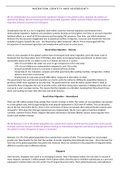Summary
Summary A* Pearson Edexcel A Level Geography Unit 4 Migration, Identity and Sovereignty Revision Notes
- Institution
- PEARSON (PEARSON)
NOT COMPLETE TOPIC! Unfortunately this doesn't cover the last enquiry question as the 2022 advanced information didn't cover it, but this is still full of useful information that can also be used for that enquiry question too! This got me an A* for A level Edexcel Geography. It's my revision notes...
[Show more]




